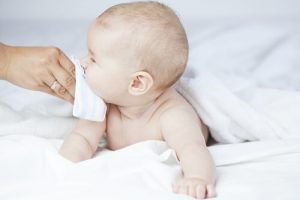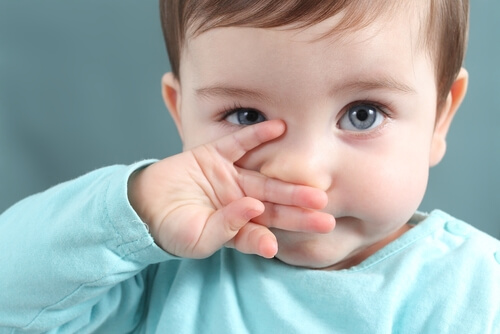Identifying and Treating Mucus in Children

Mucus in children is very common up to the age of 5. Mucus is one of the body’s defense mechanisms against infections.
When a virus comes into contact with the airways and inflames them, the body responds by producing this gelatinous material. In turn, it traps the germs so they can be expelled outside.
It’s important for parents to be well informed about this condition and its treatment. This way, they’ll know what to do if their child loses his appetite, becomes fatigued or shows other symptoms that we’ll mention below.
Although mucus doesn’t represent a serious problem in itself, it could be a sign of a more complex disease.
What are the types of mucus in children?
The types of mucus in children include:
- Clear and abundant mucus. It goes up and down the throat and some children swallow it. It’s a sign of a cold and is accompanied by constant sneezing. It can last between two and four days.
- Thick and abundant mucus. When a cold doesn’t go away, the throat begins to fight back by making even thicker mucus. Although there may not be much mucus in the child’s nose, when he lies down he begins to cough frequently.
- Green or yellow mucus. These two colors indicate that white blood cells have begun to combat an infection.
- Thick green mucus. It usually appears in the mornings. It also appears in the eyes and is a sign that the white blood cells are fighting against an infection.
- Mucus with a persistent cough and a choking sensation. If your child has trouble breathing at night and coughs a lot, it could mean he has bronchitis.
- Thick mucus accompanied by a fever. This could be a sign of a more serious infection, such as otitis or pneumonia.

Should mucus in children be treated?
Most pediatricians don’t prescribe medication to fight mucus to children under the age of 2. It’s better to treat them with simple remedies that allow them to expel the mucus.
However, they can be treated with medication if the mucus is abundant, doesn’t allow the child to breathe easily or is accompanied by a high fever.
Mucus is one of the body’s defense mechanisms against infection. When a virus comes into contact with the airways and inflames them, the body responds by producing this gelatinous material.
What methods can be used?
There are various treatments that can be used to eliminate mucus in children.
- Keep your child well hydrated. Providing plenty of water will make the mucus more fluid and help it to be expelled via coughing.
- Provide a ventilated environment. The room should be well ventilated and maintained in order to prevent fungi from forming.
- Use nasal tweezers. These are used to remove dry mucus from a baby’s nostrils.
- Use a nasal wash. These should be given with the baby lying on his side and applying a serum via syringe into each nostril. This serum can be physiological, hypertonic or sea water.
Apart from these, home remedies can also be given, such as:
- An infusion of mallow with lemon juice and honey.
- Carrot and orange juice every morning, due to its high quantity of vitamins A and C.
- Chicken broth, to reduce inflammation in the respiratory tract thanks to the cysteine compound.
Most pediatricians don’t prescribe medication for mucus to children under the age of 2.
In the event of a high fever, your pediatrician may indicate other medications, such as:
- Antihistamines
- Antibiotics
- Mucolytics
- Nebulizations

When is it necessary to bring the child to the pediatrician?
If your child has any of the following symptoms, don’t hesitate to take him to the doctor:
- Very persistent cough that causes choking. If this happens, he may have bronchitis.
- General malaise and high fever, which may be signs of otitis or pneumonia.
In conclusion, mucus in children is very common and not always harmful, because it’s a defense mechanism against infection.
However, if you notice that your child has a lot of mucus, coughs without stopping and experiences interrupted sleep, take the necessary preventative measures.
If you see that he also has other symptoms, immediately take him to the pediatrician.
Mucus in children is very common up to the age of 5. Mucus is one of the body’s defense mechanisms against infections.
When a virus comes into contact with the airways and inflames them, the body responds by producing this gelatinous material. In turn, it traps the germs so they can be expelled outside.
It’s important for parents to be well informed about this condition and its treatment. This way, they’ll know what to do if their child loses his appetite, becomes fatigued or shows other symptoms that we’ll mention below.
Although mucus doesn’t represent a serious problem in itself, it could be a sign of a more complex disease.
What are the types of mucus in children?
The types of mucus in children include:
- Clear and abundant mucus. It goes up and down the throat and some children swallow it. It’s a sign of a cold and is accompanied by constant sneezing. It can last between two and four days.
- Thick and abundant mucus. When a cold doesn’t go away, the throat begins to fight back by making even thicker mucus. Although there may not be much mucus in the child’s nose, when he lies down he begins to cough frequently.
- Green or yellow mucus. These two colors indicate that white blood cells have begun to combat an infection.
- Thick green mucus. It usually appears in the mornings. It also appears in the eyes and is a sign that the white blood cells are fighting against an infection.
- Mucus with a persistent cough and a choking sensation. If your child has trouble breathing at night and coughs a lot, it could mean he has bronchitis.
- Thick mucus accompanied by a fever. This could be a sign of a more serious infection, such as otitis or pneumonia.

Should mucus in children be treated?
Most pediatricians don’t prescribe medication to fight mucus to children under the age of 2. It’s better to treat them with simple remedies that allow them to expel the mucus.
However, they can be treated with medication if the mucus is abundant, doesn’t allow the child to breathe easily or is accompanied by a high fever.
Mucus is one of the body’s defense mechanisms against infection. When a virus comes into contact with the airways and inflames them, the body responds by producing this gelatinous material.
What methods can be used?
There are various treatments that can be used to eliminate mucus in children.
- Keep your child well hydrated. Providing plenty of water will make the mucus more fluid and help it to be expelled via coughing.
- Provide a ventilated environment. The room should be well ventilated and maintained in order to prevent fungi from forming.
- Use nasal tweezers. These are used to remove dry mucus from a baby’s nostrils.
- Use a nasal wash. These should be given with the baby lying on his side and applying a serum via syringe into each nostril. This serum can be physiological, hypertonic or sea water.
Apart from these, home remedies can also be given, such as:
- An infusion of mallow with lemon juice and honey.
- Carrot and orange juice every morning, due to its high quantity of vitamins A and C.
- Chicken broth, to reduce inflammation in the respiratory tract thanks to the cysteine compound.
Most pediatricians don’t prescribe medication for mucus to children under the age of 2.
In the event of a high fever, your pediatrician may indicate other medications, such as:
- Antihistamines
- Antibiotics
- Mucolytics
- Nebulizations

When is it necessary to bring the child to the pediatrician?
If your child has any of the following symptoms, don’t hesitate to take him to the doctor:
- Very persistent cough that causes choking. If this happens, he may have bronchitis.
- General malaise and high fever, which may be signs of otitis or pneumonia.
In conclusion, mucus in children is very common and not always harmful, because it’s a defense mechanism against infection.
However, if you notice that your child has a lot of mucus, coughs without stopping and experiences interrupted sleep, take the necessary preventative measures.
If you see that he also has other symptoms, immediately take him to the pediatrician.
All cited sources were thoroughly reviewed by our team to ensure their quality, reliability, currency, and validity. The bibliography of this article was considered reliable and of academic or scientific accuracy.
- Couloigner, V., & Van Den Abbeele, T. (2004). Rinofaringitis infantiles. EMC-Otorrinolaringología, 33(3), 1-14. https://www.ncbi.nlm.nih.gov/pmc/articles/PMC7148693/
- de Salud, C., & de Salud, S. M. (2021). Tomar antibióticos no es un juego. Catarros y Resfriados. Infecciones respiratorias vías altas. https://sms.carm.es/ricsmur/bitstream/handle/123456789/3661/20210405_Folleto_Catarros_y_Resfriados_esp.pdf?sequence=1
- Ducan F Rogers. Pulmonary mucus: pediatric perspective. Pediatric Pulmonology. https://doi.org/10.1002/ppul.10322
- Rodríguez-Valiente, A., & Vázquez-Sasot, A. (2019). CARTA AL DIRECTOR. REVISTA DE PATOLOGÍA RESPIRATORIA, 22(1). https://www.revistadepatologiarespiratoria.org/descargas/PR_22-1_35-37.pdf
- Yánez, M.; Escobar, E.; Oviedo, C.; Stillfried, A.; Pennachiotti, G. Prevalence of oral mucosal lesions in children. Int. J. Odontostomat. 10 (3): 463-468, 2016.
This text is provided for informational purposes only and does not replace consultation with a professional. If in doubt, consult your specialist.








